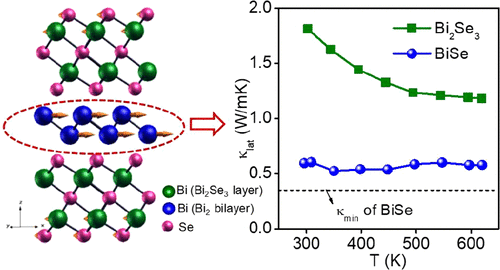当前位置:
X-MOL 学术
›
J. Am. Chem. Soc.
›
论文详情
Our official English website, www.x-mol.net, welcomes your feedback! (Note: you will need to create a separate account there.)
Localized vibrations of Bi bilayer leading to ultralow lattice thermal conductivity and high thermoelectric performance in weak topological insulator n-type BiSe
Journal of the American Chemical Society ( IF 15.0 ) Pub Date : 2018-04-11 , DOI: 10.1021/jacs.8b02691 Manisha Samanta , Koushik Pal , Provas Pal , Umesh V. Waghmare , Kanishka Biswas
Journal of the American Chemical Society ( IF 15.0 ) Pub Date : 2018-04-11 , DOI: 10.1021/jacs.8b02691 Manisha Samanta , Koushik Pal , Provas Pal , Umesh V. Waghmare , Kanishka Biswas

|
Realization of high thermoelectric performance in n-type semiconductors is of imperative need on account of the dearth of efficient n-type thermoelectric materials compared to the p-type counterpart. Moreover, development of efficient thermoelectric materials based on Te-free compounds is desirable because of the scarcity of Te in the Earth's crust. Herein, we report the intrinsic ultralow thermal conductivity and high thermoelectric performance near room temperature in n-type BiSe, a Te-free solid, which recently has emerged as a weak topological insulator. BiSe possesses a layered structure consisting of a bismuth bilayer (Bi2) sandwiched between two Bi2Se3 quintuple layers [Se-Bi-Se-Bi-Se], resembling natural heterostructure. High thermoelectric performance of BiSe is realized through the ultralow lattice thermal conductivity (κlat of ∼0.6 W/mK at 300 K), which is significantly lower than that of Bi2Se3 (κlat of ∼1.8 W/mK at 300 K), although both of them belong to the same layered homologous family (Bi2) m(Bi2Se3) n. Phonon dispersion calculated from first-principles and the experimental low-temperature specific heat data indicate that soft localized vibrations of bismuth bilayer in BiSe are responsible for its ultralow κlat. These low energy optical phonon branches couple strongly with the heat carrying acoustic phonons, and consequently suppress the phonon mean free path leading to low κlat. Further optimization of thermoelectric properties of BiSe through Sb substitution and spark plasma sintering (SPS) results in high ZT ∼ 0.8 at 425 K along the pressing direction, which is indeed remarkable among Te-free n-type thermoelectric materials near room temperature.
中文翻译:

Bi双层的局部振动导致弱拓扑绝缘体n型Bi Se 中的超低晶格热导率和高热电性能
由于与 p 型对应物相比,缺乏高效的 n 型热电材料,因此迫切需要在 n 型半导体中实现高热电性能。此外,由于地壳中缺乏 Te,因此需要开发基于无 Te 化合物的高效热电材料。在此,我们报告了 n 型 BiSe(一种不含 Te 的固体)在接近室温时固有的超低热导率和高热电性能,最近它已成为弱拓扑绝缘体。BiSe 具有层状结构,由夹在两个 Bi2Se3 五重层 [Se-Bi-Se-Bi-Se] 之间的铋双层 (Bi2) 组成,类似于天然异质结构。BiSe 的高热电性能是通过超低晶格热导率(κlat 为~0. 6 W/mK at 300 K),显着低于 Bi2Se3(300 K 时 κlat 约为 1.8 W/mK),尽管它们都属于同一层状同源家族 (Bi2) m(Bi2Se3) n。根据第一性原理计算的声子色散和实验低温比热数据表明,Bi Se 中铋双层的软局部振动是其超低 κlat 的原因。这些低能光学声子分支与携带热量的声学声子强烈耦合,从而抑制导致低 κlat 的声子平均自由程。通过 Sb 取代和放电等离子体烧结 (SPS) 进一步优化 BiSe 的热电性能,在 425 K 下沿压制方向产生了高 ZT ~ 0.8,这在接近室温的无 Te n 型热电材料中确实很显着。显着低于 Bi2Se3(300 K 时 κlat 为 ~1.8 W/mK),尽管它们都属于同一个层状同源家族 (Bi2) m(Bi2Se3) n。根据第一性原理计算的声子色散和实验低温比热数据表明,Bi Se 中铋双层的软局部振动是其超低 κlat 的原因。这些低能光学声子分支与携带热量的声学声子强烈耦合,从而抑制导致低 κlat 的声子平均自由程。通过 Sb 取代和放电等离子体烧结 (SPS) 进一步优化 BiSe 的热电性能,在 425 K 下沿压制方向产生了高 ZT ~ 0.8,这在接近室温的无 Te n 型热电材料中确实很显着。显着低于 Bi2Se3(300 K 时 κlat 为 ~1.8 W/mK),尽管它们都属于同一个层状同源家族 (Bi2) m(Bi2Se3) n。根据第一性原理计算的声子色散和实验低温比热数据表明,Bi Se 中铋双层的软局部振动是其超低 κlat 的原因。这些低能光学声子分支与携带热量的声学声子强烈耦合,从而抑制导致低 κlat 的声子平均自由程。通过 Sb 置换和放电等离子体烧结 (SPS) 进一步优化 BiSe 的热电性能,在 425 K 下沿压制方向产生了高 ZT ~ 0.8,这在接近室温的无 Te n 型热电材料中确实很显着。
更新日期:2018-04-11
中文翻译:

Bi双层的局部振动导致弱拓扑绝缘体n型Bi Se 中的超低晶格热导率和高热电性能
由于与 p 型对应物相比,缺乏高效的 n 型热电材料,因此迫切需要在 n 型半导体中实现高热电性能。此外,由于地壳中缺乏 Te,因此需要开发基于无 Te 化合物的高效热电材料。在此,我们报告了 n 型 BiSe(一种不含 Te 的固体)在接近室温时固有的超低热导率和高热电性能,最近它已成为弱拓扑绝缘体。BiSe 具有层状结构,由夹在两个 Bi2Se3 五重层 [Se-Bi-Se-Bi-Se] 之间的铋双层 (Bi2) 组成,类似于天然异质结构。BiSe 的高热电性能是通过超低晶格热导率(κlat 为~0. 6 W/mK at 300 K),显着低于 Bi2Se3(300 K 时 κlat 约为 1.8 W/mK),尽管它们都属于同一层状同源家族 (Bi2) m(Bi2Se3) n。根据第一性原理计算的声子色散和实验低温比热数据表明,Bi Se 中铋双层的软局部振动是其超低 κlat 的原因。这些低能光学声子分支与携带热量的声学声子强烈耦合,从而抑制导致低 κlat 的声子平均自由程。通过 Sb 取代和放电等离子体烧结 (SPS) 进一步优化 BiSe 的热电性能,在 425 K 下沿压制方向产生了高 ZT ~ 0.8,这在接近室温的无 Te n 型热电材料中确实很显着。显着低于 Bi2Se3(300 K 时 κlat 为 ~1.8 W/mK),尽管它们都属于同一个层状同源家族 (Bi2) m(Bi2Se3) n。根据第一性原理计算的声子色散和实验低温比热数据表明,Bi Se 中铋双层的软局部振动是其超低 κlat 的原因。这些低能光学声子分支与携带热量的声学声子强烈耦合,从而抑制导致低 κlat 的声子平均自由程。通过 Sb 取代和放电等离子体烧结 (SPS) 进一步优化 BiSe 的热电性能,在 425 K 下沿压制方向产生了高 ZT ~ 0.8,这在接近室温的无 Te n 型热电材料中确实很显着。显着低于 Bi2Se3(300 K 时 κlat 为 ~1.8 W/mK),尽管它们都属于同一个层状同源家族 (Bi2) m(Bi2Se3) n。根据第一性原理计算的声子色散和实验低温比热数据表明,Bi Se 中铋双层的软局部振动是其超低 κlat 的原因。这些低能光学声子分支与携带热量的声学声子强烈耦合,从而抑制导致低 κlat 的声子平均自由程。通过 Sb 置换和放电等离子体烧结 (SPS) 进一步优化 BiSe 的热电性能,在 425 K 下沿压制方向产生了高 ZT ~ 0.8,这在接近室温的无 Te n 型热电材料中确实很显着。



























 京公网安备 11010802027423号
京公网安备 11010802027423号